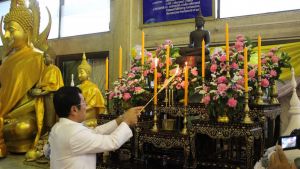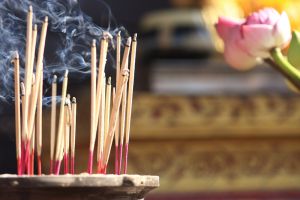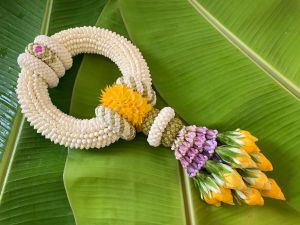Thai-style Offerings
Colorful flowers, aromatic incense sticks, and candles are among the most common offerings Thais make to Buddhist monks and Buddha images as well as people of higher rank to show their respect. Behind these offerings is a deep-rooted culture and tradition that has been handed down through generations.
The tradition has its roots in Buddhism and ancestral beliefs. Buddha and Buddhist monks are looked up to for their teachings and benevolence in helping people end suffering caused by desire and ignorance of true nature. Parents and seniors are highly regarded and appreciated for giving life and raising their children, as well as helping to develop their knowledge and experience. The feeling of gratitude also incorporates respect, compassion, and openness, which are at the heart of Thai culture. Thais, therefore, worship Buddhist monks and Buddha images and pay respect to seniors.
The act of showing such respect and gratitude is called bucha (บูชา) in Thai language. According to the Buddhist belief, there are two types of bucha: Patibat Bucha (ปฏิบัติบูชา) and Amis Bucha (อามิสบูชา).
Patibat Bucha means worshipping by behaving morally, following Buddhist precepts, meditating, and praying. This is believed to be the best kind of offering as it purifies the soul and focuses on the three gems in Buddhism – Buddha, dharma (Buddha’s teaching), and monks. When the soul is purified, natural wisdom will be unlocked.
Amis Bucha means worshipping or showing gratitude through physical offerings like flowers, candles, incense, arts, and crafts. Thai physical offerings are finely crafted with great care, reflecting the refined nature of the Thai people and the level of respect they have. Generally, the offerings made in the palace are more delicate and lavishly decorated than those made by common people.
But whether they are made in the palace or in the homes of ordinary people, the offerings include the same four objects – Khao Tok (ข้าวตอก) or popped rice, flowers, candles, and incense sticks.
Popped Rice
According to Buddhist beliefs, popped rice is considered a purified offering that reflects the three qualities of Lord Buddha. The explosion emanating from the puffing of the kernels represents flourishing wisdom and boundless compassion and the whiteness the purity.
Popped rice has been one of the main offerings in Thai culture for centuries, not only in the central region but also in the North and Northeast. For instance, people in the northeastern region have the popped rice garland procession. In the North, people make merit by offering a silver bowl of popped rice to monks during the New Year festival.
Popped rice can be decorated in different ways. The simplest decoration is to put the kernels in a bowl or banana leaf cones. They can also be strung together as a garland or stuck to a coconut leaf stem and placed in a vase. More sophisticated versions see water sprayed on the popped rice and the moist kernels pressed into a dome shape. Sometimes, popped rice is mixed with flower petals and placed on a tray or sprinkled on the floor.
Popped rice is also used as an offering at other auspicious events including wedding ceremonies and at the wai khru ceremony where students pay respect to teachers.
The second main offering is composed of flowers, which reflect beauty, purity, and auspiciousness. These include beautifully shaped blooms, like white lotus and jasmine; blossoms in cool tones such as green, blue, and violet; those with beautiful names, such as Puttaraksa (cannaceae, which literally means protected by Buddha) and Ban Mai Roo Roi (amaranth, which literally means forever blooming in Thai). Also favored are those considered as symbolizing a good nature, such as eggplant flowers which bend to the ground suggesting humility and modesty – the qualities appreciated in Thai culture and Buddhist beliefs.
Once the meaningful flowers are selected, they are made into different forms like a bouquet, stuck on coconut leaf stems, or used to make a Phan Phoom (พานพุ่ม) or “flower tray”. Phan Phoom is fashioned from a light-weight wood dome about six inches or 15 centimeters tall to which flowers or petals are stuck. It is usually made for sacred or auspicious occasions. The flower tray with a nine-tier umbrella is reserved for the king.
Sometimes, flowers are knitted into a net to be hung on the walls and windows. Called Khrueang Kwan (เครื่องแขวน) or hanging flowers, this flower net is considered a fine art and used in auspicious ceremonies.
Candles bring light. This offering reflects Dharma or Buddha’s teaching. Candles are one of the oldest offerings in Thai culture. In bygone days, candles were made from natural wax and cotton string. They are sometimes delicately carved to show the deepest gratitude and faith in the religion.
Like other highly decorated items, candles that are used as offerings come in different forms depending on the imagination of their creator. They can be simple and take the form of either horizontal or vertical candle bundles, each tied with plain string or colorful papers. Some are made in the mondop (มณฑป) shape by piling candles in a pyramidal square form similar to a Thai building structure with the pointed roof known as the mondop. The mondop candles will not be lit as they are considered sacred.
Others can be lavishly carved and decorated. The wax castle, for example, is an ancient candle offering. Here, sweet potatoes and banana stems, carved into flowers and different forms, are used as the mold. The mold is then dipped in hot melted wax to form different shapes that are later used as decorations or to make the wax castle. The Thian Phoom (เทียนพุ่ม), or wax dome, is a rare art, one that only few artisans are able to create today. It requires the slow dripping of melted wax onto a tray or a cone-shape structure until it forms a dome.
The last offering, though certainly not the least, is aromatic incense sticks. When lit, the scent from the incense sticks lingers in the air and is believed to bring blessings. Historical evidence shows that incense has been used as an offering since the Sukhothai period, an ancient kingdom in the North that existed from 1238 until 1438.
Thoop Hom (ธูปหอม), sometimes called Thoop Krajae (ธูปกระแจะ) or Thoop Thai (ธูปไทย), are aromatic incense sticks. They are shorter and fatter and give off a sweeter aroma than their Chinese counterparts. They are usually lit together with wax candles in Buddhist ceremonies or offered to teachers and seniors as a way to pay respect.
Different forms of incense are used for different occasions. Thoop Yai (ธูปใหญ่) or a large incense stick is fat and used together with other offerings. When Thoop Yai are cut shorter and bundled together with candles, they are called Thoop Thian Phae (ธูปเทียนแพ), literally a raft of incense and candles. Thoop Thian Phae is generally used in ordination ceremonies.
While the paying of respect starts with four offerings – popped rice, flowers, candles and incense sticks – the presentation and details of the offerings can vary from region to region. Offerings can also signify social status, with offerings used in royal ceremonies being more lavish and intricate.
More importantly, the differences in the styles and forms of these offerings clearly underline the essence of Thai culture of respect and appreciation of fine art. When you see these offerings, look deep inside to appreciate the passion, the craftsmanship, the beliefs, and the true nature of Thai culture.
Reference
Komalakul na Nakorn, Thakur. [How to make a Thai offering] Watthanatham Journal: Department of Cultural Promotion, vol. 55, no. 4, October-December 2016, p.26-33. Available at http://magazine.culture.go.th/2016/4/mobile/index.html#p=ปกหน้า.


